- Regulatory Status
- RUO
- Other Names
- Tumor necrosis factor receptor superfamily member 5, TNFRSF5, B-cell surface antigen CD40, Bp50, CD40L receptor, CDw40
- Ave. Rating
- Submit a Review
- Product Citations
- publications
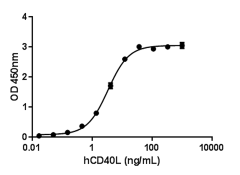
-

When recombinant human CD40/TNFRSF5-Fc Chimera is immobilized at 1 µg/mL, biotinylated recombinant human CD40L binds with ED50 of 3 - 12 ng/mL in a functional ELISA. -
Stability testing for recombinant human CD40/TNFRSF5-Fc Chimera. Recombinant human CD40/TNFRSF5-Fc Chimera was aliquoted in PBS, pH 7.2 at 0.2 mg/mL. One aliquot was frozen and thawed four times (4x freeze/thaws), and compared to a control kept at 4°C (control). The samples were tested in a binding assay with biotinylated recombinant human CD40L.
CD40, also known as TNFRSF5, is a type I transmembrane protein that belongs to the TNF receptor family (TNFR). CD40 is expressed on B cells, dendritic cells, monocytes, macrophages, platelets, basal epithelial cells, endothelial cells and a subset of CD34+ hematopoietic progenitors. The interaction between CD40 and its ligand TNFSF5/CD40L leads to the clustering of CD40 and the recruitment of TNFR associated factors (TRAFs), including TRAF1, 2, 3, 5 and 6. TRAF1, 2, 5 and 6 serve as positive regulators while TRAF3 is a negative regulator. CD40/CD40L interaction triggers downstream signaling on both cells, including upregulation of CD40 and cell survival on dendritic cells, upregulation of co-stimulatory molecules, CD80 and CD86 on T cells, and production of inflammatory cytokines. In addition, CD40 regulates B cell development/maturation, Ig isotype switching and in combination with other signals such as IL-4, promotes proliferation. It has been reported that a transcriptional factor, AKNA, can coordinately regulate the expression of CD40 and CD40L. Dysregulation of CD40 is associated with several diseases, such as hyper-IgM immunodeficiency type 3 (HIGM3) and Hodgkin's disease. Targeting of CD40/CD40L for cancer therapy is being evaluated in clinical trials, including anti-CD40 agonist antibodies and soluble recombinant CD40L. Several isoforms have been identified in human and mice.
Product DetailsProduct Details
- Source
- Human CD40, amino acid Glu21-Arg193 (Accession # P25942), with a C-terminal human IgG1 (Pro100-Lys330) and 6His tag, was expressed in 293E cells.
- Molecular Mass
- The 414 amino acid recombinant protein has a predicted molecular mass of approximately 46.3 kD. The DTT-reduced and non-reduced protein migrates at approximately 55 and 100 kD respectively by SDS-PAGE. The predicted N-terminal amino acid is Glu.
- Purity
- > 98%, as determined by Coomassie stained SDS-PAGE.
- Formulation
- 0.22 µm filtered protein solution is in PBS, pH 7.2.
- Endotoxin Level
- Less than 0.1 EU per µg protein as determined by the LAL method.
- Concentration
- 10 and 25 µg sizes are bottled at 200 µg/mL. 100 µg size and larger sizes are lot-specific and bottled at the concentration indicated on the vial. To obtain lot-specific concentration and expiration, please enter the lot number in our Certificate of Analysis online tool.
- Storage & Handling
- Unopened vial can be stored between 2°C and 8°C for up to 2 weeks, at -20°C for up to six months, or at -70°C or colder until the expiration date. For maximum results, quick spin vial prior to opening. The protein can be aliquoted and stored at -20°C or colder. Stock solutions can also be prepared at 50 - 100 µg/mL in appropriate sterile buffer, carrier protein such as 0.2 - 1% BSA or HSA can be added when preparing the stock solution. Aliquots can be stored between 2°C and 8°C for up to one week and stored at -20°C or colder for up to 3 months. Avoid repeated freeze/thaw cycles.
- Activity
- When recombinant human CD40/TNFRSF5-Fc Chimera is immobilized at 1 µg/mL, biotinylated recombinant human CD40L binds with an ED50 of 3 - 12 ng/mL in a functional ELISA.
- Application
-
Bioassay
- Application Notes
-
BioLegend carrier-free recombinant proteins provided in liquid format are shipped on blue ice. Our comparison testing data indicates that when handled and stored as recommended, the liquid format has equal or better stability and shelf-life compared to commercially available lyophilized proteins after reconstitution. Our liquid proteins are verified in-house to maintain activity after shipping on blue ice and are backed by our 100% satisfaction guarantee. If you have any concerns, contact us at tech@biolegend.com.
- Product Citations
-
Antigen Details
- Structure
- Disulfide bond-linked homodimer
- Distribution
-
B cells, dendritic cells, monocytes, macrophages, platelets, basal epithelial cells, endothelial cells and a subset of CD34+ hematopoietic progenitors, primary carcinomas.
- Function
- CD40 regulates B cell development/maturation, Ig isotype switching proliferation. CD40 is also involved in T cell priming and inflammatory cytokine production.
- Interaction
- TRAF1, 2, 3, 5, 6
- Ligand/Receptor
- TNFSF5/CD40L
- Bioactivity
- Measured by its ability to bind human CD40L.
- Cell Type
- B cells, Dendritic cells
- Biology Area
- Costimulatory Molecules, Immunology
- Molecular Family
- Immune Checkpoint Receptors, Soluble Receptors
- Antigen References
-
- Ridge JP, et al. 1998. Nature 393:474.
- Schoenberger SP, et al. 1998. Nature 393:480.
- Bremer E. 2013. ISRN Oncol. 2013:371854.
- Siddiqa A, et al. 2001. Nature 410: 383.
- Durandy A, et al. 2005. Immunol. Rev. 203:67.
- O'Grady JT, et al. 1994. Am. J. Pathol. 144:21.
- Karaca NE, et al. 2012. Scand. J. Immunol. 76:21.
- Tone M, et al. 2001. Proc. Natl. Acad. Sci. USA. 98:1751.
- Eshel D, et al. 2008. Mol. Immunol. 46:250.
- Hostager BS, et al. 2000. J. Biol. Chem. 275:15392.
- Elgueta R, et al. 2009. Immunol. Rev. 229:152.
- Gene ID
- 958 View all products for this Gene ID
- UniProt
- View information about CD40 on UniProt.org
Related FAQs
- Why choose BioLegend recombinant proteins?
-
• Each lot of product is quality-tested for bioactivity as indicated on the data sheet.
• Greater than 95% Purity or higher, tested on every lot of product.
• 100% Satisfaction Guarantee for quality performance, stability, and consistency.
• Ready-to-use liquid format saves time and reduces challenges associated with reconstitution.
• Bulk and customization available. Contact us.
• Learn more about our Recombinant Proteins. - How does the activity of your recombinant proteins compare to competitors?
-
We quality control each and every lot of recombinant protein. Not only do we check its bioactivity, but we also compare it against other commercially available recombinant proteins. We make sure each recombinant protein’s activity is at least as good as or better than the competition’s. In order to provide you with the best possible product, we ensure that our testing process is rigorous and thorough. If you’re curious and eager to make the switch to BioLegend recombinants, contact your sales representative today!
- What is the specific activity or ED50 of my recombinant protein?
-
The specific activity range of the protein is indicated on the product datasheets. Because the exact activity values on a per unit basis can largely fluctuate depending on a number of factors, including the nature of the assay, cell density, age of cells/passage number, culture media used, and end user technique, the specific activity is best defined as a range and we guarantee the specific activity of all our lots will be within the range indicated on the datasheet. Please note this only applies to recombinants labeled for use in bioassays. ELISA standard recombinant proteins are not recommended for bioassay usage as they are not tested for these applications.
- Have your recombinants been tested for stability?
-
Our testing shows that the recombinant proteins are able to withstand room temperature for a week without losing activity. In addition the recombinant proteins were also found to withstand four cycles of freeze and thaw without losing activity.
- Does specific activity of a recombinant protein vary between lots?
-
Specific activity will vary for each lot and for the type of experiment that is done to validate it, but all passed lots will have activity within the established ED50 range for the product and we guarantee that our products will have lot-to-lot consistency. Please conduct an experiment-specific validation to find the optimal ED50 for your system.
- How do you convert activity as an ED50 in ng/ml to a specific activity in Units/mg?
-
Use formula Specific activity (Units/mg) = 10^6/ ED50 (ng/mL)
 Login / Register
Login / Register 







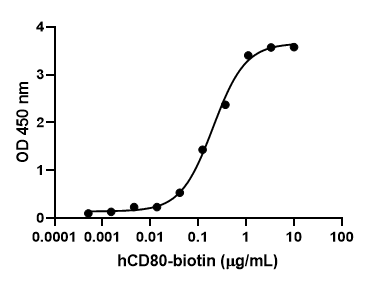
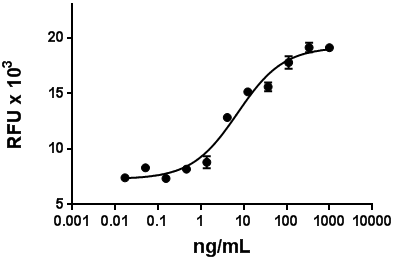
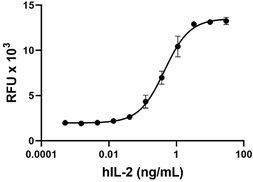
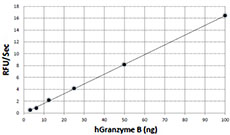



Follow Us